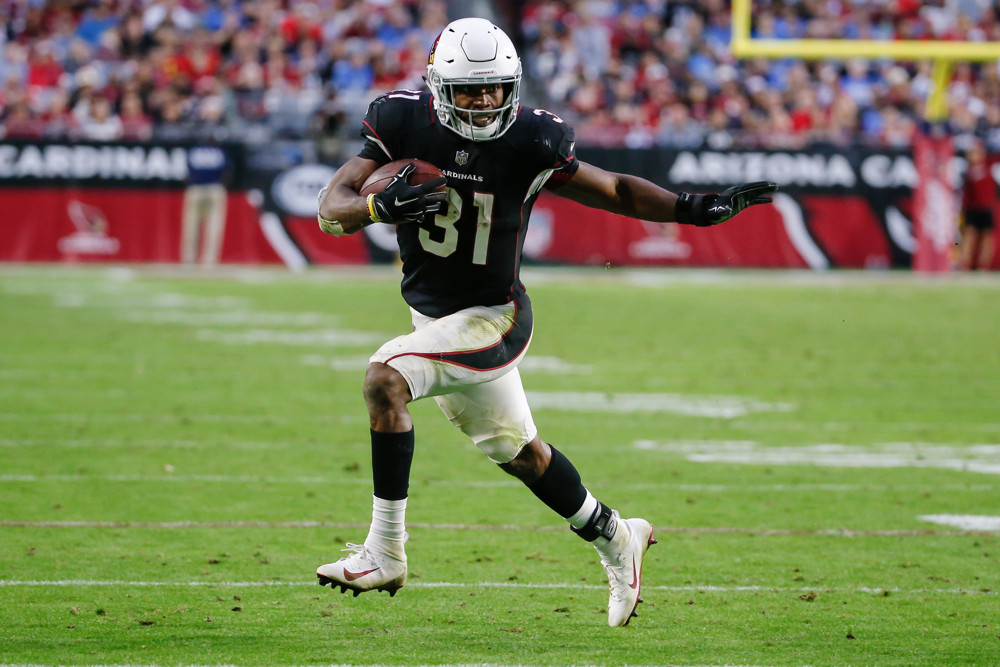Last Updated: July 18, 2019 at 2:06pm ET.
Cardinals 2014-2018 Offensive Profile
2014-2018 Pass Attempts Rank: 15th, 19th, 3rd, 5th, 29th
2014-2018 Rush Attempts Rank: 24th, 9th, 21st, 20th, 28th
2014-2018 Play Volume Rank: 26th, 15th, 2nd, 5th, 31st
2014-2018 Yards Per Play Rank: 25th, 1st, 19th, 30th, 32nd
Unaccounted for Targets from 2018 (Rank): 37 (29th)
Unaccounted for Carries from 2018 (Rank): 31 (24th)
Projected Starting Lineup
QB: Kyler Murray
RB: David Johnson
WR: Christian Kirk
WR: Andy Isabella
WR: Larry Fitzgerald
TE: Charles Clay
LT: D.J. Humphries
LG: J.R. Sweezy
C: Mason Cole
RG: Justin Pugh
RT: Marcus Gilbert
Cardinals Passing Game
The Cardinals made Kyler Murray this year’s No. 1 overall pick after Murray earned the 2018 Heisman Trophy playing in the same Lincoln Riley-coached offense that produced Baker Mayfield. Previously viewed as a baseball prospect after going ninth overall to Billy Beane’s A’s in the 2018 MLB draft, Murray emerged as the top prospect in his favorite sport by completing 69% of his passes at an absurd 11.6 yards per attempt with a 42:7 TD-to-INT ratio and 12 additional rushing scores in his lone season as Oklahoma’s starter. In Arizona, Murray’s lightning-fast release, dual threat, and ability to launch from multiple angles will help offset pass-protection flaws cement-footed predecessors Sam Bradford and Josh Rosen couldn’t. New coach Kliff Kingsbury’s quick-hitting offense also eased protection burdens in the Big 12; only one Red Raiders offensive lineman has been drafted since 2009, yet Texas Tech allowed college football’s fourth-lowest sack rate (3.7%) over the past five years. Kingsbury’s aggressive, fast-paced Air Raid spread perfectly suits Murray’s playing style; whereas last year’s Cardinals finished second to last in the NFL in play volume, Texas Tech led Division I in offensive plays per game (82) over Kingsbury’s six seasons as coach. Like fellow two-way scoring threats Deshaun Watson, Dak Prescott, Russell Wilson, and Cam Newton, Murray is capable of carving out QB1 fantasy production as a rookie.
2018 No. 47 overall pick Christian Kirk shook off a slow rookie-year start to clear 75 yards and/or score a touchdown in five of his final ten games before breaking his foot in Week 13. Even as his skill set coming out of college best projected to the slot, Kirk deferred to Hall of Fame slot man Larry Fitzgerald and ran 70% of his routes outside. Kirk did dominate on his interior opportunities, securing 15-of-20 slot targets for 196 yards and a touchdown with 1.90 yards per slot route run versus Fitz’s sluggish 1.36. At Texas Tech, Kingsbury used smaller Jakeem Grant, Keke Coutee, Bradley Marquez, and Jonathan Giles inside with larger Antoine Wesley and Dylan Cantrell outside, suggesting 5-foot-10, 201-pound Kirk’s slot usage will rise. Assuming rational coaching, Kirk will pass Fitzgerald as Arizona’s go-to receiver this year.
Larry Fitzgerald re-signed a one-year, $11 million deal to presumably finish his career in Arizona after backsliding in all relevant efficiency marks last season. Fitzgerald’s 6.6 yards per target were his fewest since John Skelton, Kevin Kolb, and Ryan Lindley’s 2012 Cardinals, and Fitz’s 1.38 yards per route run ranked 35th among 40 qualified wide receivers who played at least 50% of their team’s snaps. Even as Fitz started all 16 games, his 734 yards were the fewest of Fitzgerald’s 15-year career. Kingsbury’s history of deploying big receivers outside bodes poorly for Fitzgerald (6’3/225), who no longer separates versus press-man coverage. Although Fitzgerald’s first-team role remains secure, there are reasons to believe he’ll be passed by two if not three teammates as the Cardinals’ offensive focal point.
The Cardinals turned 2018 top-ten flop Josh Rosen into 2019 No. 62 overall pick Andy Isabella, who stands 5-foot-9, 188 and shuttled inside and out at UMass, leading the nation in 2018 receiving yards (1,698) and yards per route run (4.15). Isabella blazed 4.31 at February’s Combine, then drew pre-draft comparisons to Brandin Cooks. Isabella’s third-receiver competition consists of 2018 third-round slug Chad Williams, Bears bust Kevin White, fourth-round Plaxico Burress lookalike Hakeem Butler, and sixth-round possession prospect Keesean Johnson. Isabella best profiles with aforementioned Kingsbury slot machines Bradley Marquez (65/821/10 in 2014), Jakeem Grant (90/1,268/10 in 2015), Jonathan Giles (69/1,158/13 in 2016), and Keke Coutee (93/1,429/10 in 2017). Taller drinks Williams, White, and Butler project to the outside under Kingsbury, where Dylan Cantrell (71/816/7 in 2017) and Antoine Wesley (88/1,419/9 in 2018) churned stats. From Jace Amaro to Coutee and Wesley, Kingsbury clearly awarded targets to pass catchers that earned them in a meritocracy rather than position-based scheme.
Charles Clay, Ricky Seals-Jones, and Maxx Williams will compete as probable tight end afterthoughts in Kingsbury’s wideout-focused spread. The Cardinals threw a one-year, $2 million dart at Clay after he looked washed in 2018’s career-worst 184-yard year. Seals-Jones was, quantifiably, the league’s worst tight end last season, but his high-school recruiting connection to Kingsbury and Air Raid experience bear mentioning. The 55th overall pick in the 2015 draft by Baltimore, Williams is still only 25 years old.
Cardinals Running Game
David Johnson was commonly seen as a fantasy dud despite finishing as last year’s PPR RB9 and non-PPR RB10, not quite “winning weeks” as he did in 2016 but still scoring ten touchdowns and totaling 87 yards per game in the league’s worst offense. As the Cardinals made no meaningful backfield additions, Johnson’s workload projection remains intact after averaging 19.3 touches last year. The Cardinals added interior brawler J.R. Sweezy in free agency and stud Steelers RT Marcus Gilbert via trade, while Kingsbury’s spread packages are a pleasant departure from 2018 OC Mike McCoy’s bunch formations that invited eight men into the box. Not to be overlooked is Arizona’s hire of OL coach Sean Kugler, whose 2018 Broncos line ranked No. 6 in Football Outsiders’ Adjusted Line Yards run-blocking metric. Albeit known as a pass-oriented coach, Kingsbury has featured running backs when they are the best players on his team. Last year’s Red Raiders averaged 131 rushing yards per game, and Oakland 2016 fifth-round pick DeAndre Washington logged a prolific 233/1,492/14 rushing line and averaged 144.4 total yards per game for Kingsbury’s 2015 Tech squad. Combine Kingsbury’s space-creating offense with Murray’s lane-opening dual threat, and Johnson is safely a top-five overall pick in season-long leagues.
Chase Edmonds emerged as one of fantasy football’s top handcuffs by logging 90% of Arizona’s 2018 non-Johnson running back snaps and earning 80 rookie-year touches as Johnson’s breather back. The Cardinals made no meaningful offseason backfield additions, ensuring Edmonds’ clear-cut No. 2 job is safe. At 5-foot-9, 205 with 4.55 wheels and an all-purpose game, Edmonds resembles a poor man’s Devonta Freeman. Edmonds would at very least offer RB2 potential if Johnson were to miss time and is worth drafting late in all leagues in an offense where play volume should spike, enhancing opportunity.
2019 Vegas Win Total
The Cardinals’ Win Total opened at 5.0, a seeming value since they are positive-regression candidates in many areas and should be energized by dynamic dual-threat quarterback play in Kingsbury’s progressive offense. Last year’s team went 2-4 in one-score games and experienced impossibly sub-par coaching on both sides of the ball. The Cardinals lost their best player for a month and a half from Patrick Peterson’s PEDs suspension, however, and their Opponent Win Totals-based Strength of Schedule is tenth toughest in the league. I’m taking the over on the Cardinals winning five games, but not without trepidation.



